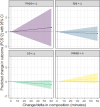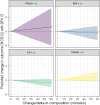Measuring 24-h use of time in people with a diabetes-related foot ulcer: A feasibility study
- PMID: 39080913
- PMCID: PMC11633338
- DOI: 10.1002/jfa2.12045
Measuring 24-h use of time in people with a diabetes-related foot ulcer: A feasibility study
Abstract
Background: Physical activity (PA), sleep and sedentary time are now recognised as mutually exclusive and exhaustive parts of the 24-h day-if PA decreases, time spent sleeping, being sedentary or both must increase so that all components equate to 24 h. Recent advances in time-use epidemiology suggest that we should not consider time-use domains (PA, sleep and sedentary time) in isolation from each other, but in terms of a composition-the mix of time-use domains across the 24-h day. While interrelated daily activities are known to be important in the management of diabetes mellitus, few studies have investigated the interrelated daily activities in people with an active diabetes-related foot ulcer (DFU) and their impact on important outcomes such as wound severity, blood glucose control and health-related quality of life (HRQoL). This feasibility study aims to determine the acceptability and practicality of measuring 24-h use of time data in people with a DFU and its associations on important outcome measures for this population.
Methods: Participants wore a wrist-worn accelerometer for two weeks and completed demographic and HRQoL questionnaires. Outcomes were participant engagement, reported levels of study burden and value and compositional data analysis as a methodological approach for evaluating 24-h use of time data.
Results: Twenty-six participants reported low levels of study burden and rated the study value highly. The protocol appears feasible in terms of recruitment (81%) and retention rate (86%). On average, participants were relatively sedentary spending 747, 172 and 18 min in sedentary time, light physical activity and moderate-to-vigorous activity, respectively. Sleep appeared adequate with participants obtaining an average of 485 min, but quality of sleep was notably poor with average sleep efficiency of 75%. Compositional data analysis was able to quantify the integrated associations of 24-h use of time with HRQoL.
Conclusion: The protocol provides an acceptable method to collect 24-h use of time data in people with a DFU. Efforts to consider and analyse PA as part of a 24-h activity composition may provide holistic and realistic understandings of PA in this clinical population.
Keywords: diabetes; diabetes mellitus; diabetes‐related foot ulcer; physical activity; sedentary behaviour.
© 2024 The Author(s). Journal of Foot and Ankle Research published by John Wiley & Sons Australia, Ltd on behalf of Australian Podiatry Association and The Royal College of Podiatry.
Conflict of interest statement
All the authors declare that they have no conflicts of interest.
Figures



Similar articles
-
Specific physical activities, sedentary behaviours and sleep as long-term predictors of accelerometer-measured physical activity in 91,648 adults: a prospective cohort study.Int J Behav Nutr Phys Act. 2019 May 7;16(1):41. doi: 10.1186/s12966-019-0802-9. Int J Behav Nutr Phys Act. 2019. PMID: 31064403 Free PMC article.
-
Associations of Activity and Sleep With Quality of Life: A Compositional Data Analysis.Am J Prev Med. 2020 Sep;59(3):412-419. doi: 10.1016/j.amepre.2020.03.029. Epub 2020 Jul 23. Am J Prev Med. 2020. PMID: 32713616
-
Moderate-to-Vigorous-Intensity Physical Activity Observed in People With Diabetes-Related Foot Ulcers Over a One-Week Period.J Diabetes Sci Technol. 2019 Sep;13(5):827-835. doi: 10.1177/1932296819848735. Epub 2019 May 29. J Diabetes Sci Technol. 2019. PMID: 31137944 Free PMC article.
-
Health outcomes associated with reallocations of time between sleep, sedentary behaviour, and physical activity: a systematic scoping review of isotemporal substitution studies.Int J Behav Nutr Phys Act. 2018 Jul 13;15(1):69. doi: 10.1186/s12966-018-0691-3. Int J Behav Nutr Phys Act. 2018. PMID: 30001713 Free PMC article.
-
A systematic review of compositional data analysis studies examining associations between sleep, sedentary behaviour, and physical activity with health outcomes in adults.Appl Physiol Nutr Metab. 2020 Oct;45(10 (Suppl. 2)):S248-S257. doi: 10.1139/apnm-2020-0160. Appl Physiol Nutr Metab. 2020. PMID: 33054342
Cited by
-
Exploring Physical Activity in Individuals With Type 2 Diabetes Mellitus and Lower Limb Complications: A Scoping Review.Endocrinol Diabetes Metab. 2025 Jul;8(4):e70084. doi: 10.1002/edm2.70084. Endocrinol Diabetes Metab. 2025. PMID: 40683848 Free PMC article.
References
-
- Armstrong, D. G. , Swerdlow M. A., Armstrong A. A., Conte M. S., Padula W. V., and Bus S. A.. 2020. “Five Year Mortality and Direct Costs of Care for People with Diabetic Foot Complications Are Comparable to Cancer.” Journal of Foot and Ankle Research 13(1). 10.1186/s13047-020-00383-2. - DOI - PMC - PubMed
MeSH terms
LinkOut - more resources
Full Text Sources
Medical

